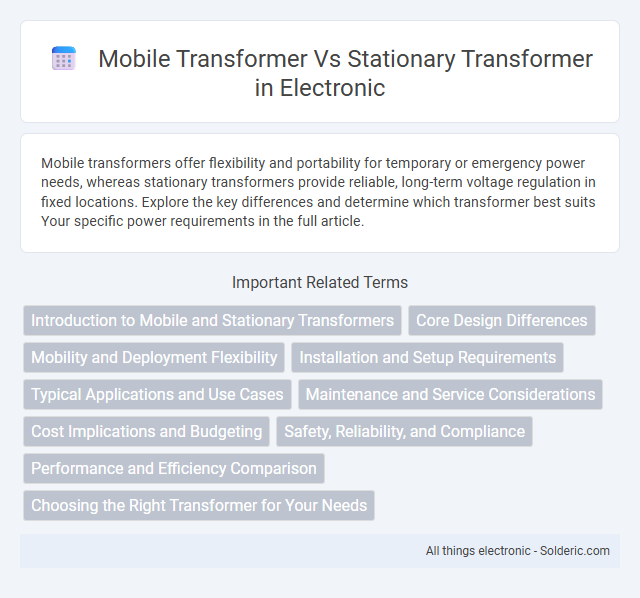Mobile transformers offer flexibility and portability for temporary or emergency power needs, whereas stationary transformers provide reliable, long-term voltage regulation in fixed locations. Explore the key differences and determine which transformer best suits Your specific power requirements in the full article.
Comparison Table
| Feature | Mobile Transformer | Stationary Transformer |
|---|---|---|
| Portability | Designed for easy relocation and transport | Fixed installation, not intended for movement |
| Application | Temporary power supply in remote or emergency sites | Permanent power distribution in substations and buildings |
| Size & Weight | Compact, lightweight for transportability | Larger, heavier due to permanently fixed installation |
| Installation | Minimal setup, plug-and-play capability | Complex installation with foundation and cabling |
| Cooling Method | Self-cooled or forced air for mobility | Oil-immersed or air-cooled, optimized for fixed use |
| Durability | Built to withstand transport shocks and vibrations | Designed for long-term stable operation |
| Cost | Higher unit cost due to mobility features | Lower unit cost for mass permanent deployment |
| Voltage Ratings | Typically lower, suited for flexible needs | Wide range, including high voltage for grid applications |
| Maintenance | Frequent checks needed due to portability | Routine maintenance based on fixed schedules |
Introduction to Mobile and Stationary Transformers
Mobile transformers offer flexible power distribution for temporary or remote sites, providing easy relocation and rapid deployment. Stationary transformers are designed for permanent installations, ensuring stable and reliable voltage regulation for industrial, commercial, or residential applications. Your choice depends on the need for mobility, installation duration, and specific load requirements.
Core Design Differences
Mobile transformers feature a compact, lightweight core design optimized for portability and quick deployment, often using amorphous steel cores to reduce size and weight. Stationary transformers utilize larger, more robust core structures with silicon steel laminations designed for efficient heat dissipation and long-term stability in fixed installations. Understanding these core design differences helps you select the appropriate transformer type based on mobility requirements and operational environment.
Mobility and Deployment Flexibility
Mobile transformers offer superior mobility, enabling rapid deployment and relocation to various sites as your power needs change. Stationary transformers, while robust and efficient for long-term use, lack this flexibility due to their fixed installation. Choosing a mobile transformer enhances operational agility, especially in industries requiring temporary or emergency power solutions.
Installation and Setup Requirements
Mobile transformers require minimal installation effort, often designed for plug-and-play operation with quick connection to existing power systems, making them ideal for temporary or emergency applications. Stationary transformers demand extensive site preparation, including foundation construction, heavy-duty electrical wiring, and compliance with strict safety and environmental regulations. The setup time for stationary transformers can span several days to weeks, whereas mobile transformers can be operational within hours, optimizing deployment in dynamic or short-term scenarios.
Typical Applications and Use Cases
Mobile transformers are commonly used in emergency power restoration, temporary construction sites, and outdoor events where quick deployment and flexibility are crucial. Stationary transformers are typically installed in substations, industrial plants, and residential power distribution systems for long-term, stable voltage regulation and energy transfer. Both types serve essential roles in managing electrical loads, but mobile transformers excel in scenarios requiring rapid setup and mobility.
Maintenance and Service Considerations
Mobile transformers require more frequent maintenance due to constant exposure to varying environmental conditions and transportation stresses, impacting components like insulation and cooling systems. Stationary transformers benefit from stable installation environments, resulting in longer intervals between inspections and reduced servicing costs. Understanding these differences helps you plan maintenance schedules effectively, ensuring reliability and minimizing downtime.
Cost Implications and Budgeting
Mobile transformers generally incur higher initial costs due to added portability features and rugged design requirements compared to stationary transformers, which benefit from economies of scale in mass production and installation. Maintenance expenses for mobile transformers can be elevated because of frequent transport and exposure to varying environmental conditions, increasing the need for inspections and repairs. Budgeting for mobile transformers must accommodate these variables alongside potential downtime costs, while stationary transformer budgets often focus on long-term operational efficiency and fixed installation expenses.
Safety, Reliability, and Compliance
Mobile transformers offer enhanced safety features such as built-in protective relays and portable grounding systems, ensuring protection during transportation and temporary installations. Stationary transformers provide higher reliability through robust construction and consistent cooling mechanisms designed for long-term operation in fixed locations. Both transformer types must comply with industry standards like IEEE and IEC, but your choice should align with the specific safety protocols and reliability requirements of your application environment.
Performance and Efficiency Comparison
Mobile transformers typically offer lower efficiency than stationary transformers due to their compact design and mobility constraints, which affect cooling and insulation performance. Stationary transformers provide superior performance with higher power ratings, better thermal management, and longer service life, optimized for consistent load conditions. Efficiency differences arise from construction materials and design focus, with stationary transformers achieving around 98-99% efficiency, while mobile transformers often range between 95-97%.
Choosing the Right Transformer for Your Needs
Mobile transformers offer flexibility and rapid deployment for temporary or emergency power needs, making them ideal for construction sites and outdoor events. Stationary transformers provide reliable, long-term voltage regulation and energy distribution for industrial facilities, commercial buildings, and residential areas. Evaluate factors such as load capacity, installation environment, maintenance requirements, and budget to determine the most suitable transformer type for your specific application.
mobile transformer vs stationary transformer Infographic

 solderic.com
solderic.com